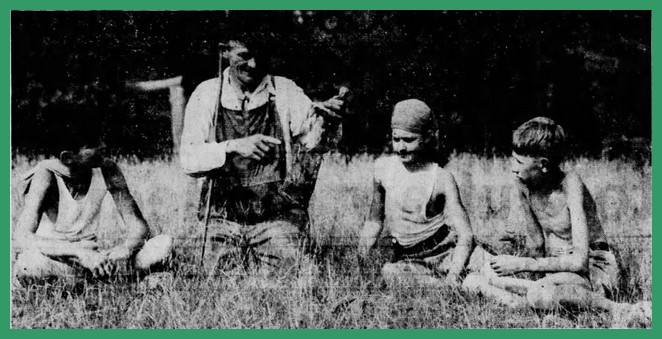A photograph of Clair Guy Wingert, of Clarks Valley, Dauphin County, Pennsylvania, and three young boys, supposedly taken in July 1937 at the Y.M.C.A. camp near Dauphin Borough, Dauphin County, Pennsylvania.
In September 1937, Clair Guy Wingert, a trapper from near Clarks Valley, Dauphin County, fired shots at William McElwee and his wife Dorothy McElwee, who he claimed had poisoned his toe. The shots killed William McElwee and seriously wounded Dorothy McElwee.
The photo appeared in the Harrisburg Telegraph, 20 February 1937 and was accompanied by the following caption:
Clair Guy Wingert, held in the shooting of a man and his wife hear Dauphin, was long-known in that section as a fisherman, hunter and trapper. In this picture taken last July, Wingert is showing three boys from Y.M.C.A. Camp Shikellimy, how he catches insects to use for bait to tempt the tinny tribe in Clarks Creek. On his left is Arnold Rosgow and on the right are Edgar Hoffman and William Hilton.
___________________________________
A portion of an article that appeared in the Harrisburg Evening News of 22 February 1937, attempted to explain Wingert’s relationship to the Y.M.C.A. Camp:
Wingert, who made his living by hunting and trapping and doing odd jobs, was known throughout Clarks Valley and vicinity as “Huckleberry,” a nickname given him by children who learned to know him while attending Camp Chikellimy. He had no official connection with the camp, according to officials of the Y.M.C.A.
Many youthful campers, as well as residents of Clarks Valley, at whose home Wingert was a frequent visitor, were repeating today fantastic stories it was his habit to relate in his friendly efforts to amuse any one who cared to listen.
Called “Peculiar”
Because of his “peculiar” actions and the fact that he always carried a revolver, Wingert was never permitted by camp officials to be alone with the campers.
An example of the stories Wingert told, was related today by two local youths who met the accused man several years ago at Camp Shikellimy.
The two youths said they had hiked to the camp after its season had ended and obtained permission to spend several nights there. Late on the first night of their stay in one of the camp huts they were approached by Wingert. He immediately became friendly with the youths after learning they had obtained permission to stop at the camp.
They recalled that he had told them that night that he was walking along a mountain road nearby, carrying a lantern, when suddenly a shot rang out and the lantern dropped from his hand.
Stories of his hunting and trapping are said to have been the most interesting yarns the simple-minded man told children attending the camp.
It was not known today by Sheriff W. W. Caldwell or at the local barracks of the State Police whether the accused man possessed a permit required by law to carry a weapon. Residents of Clarks Valley said he had carried a revolver for a number of years.
Corp. Henry W. Buckbee, who preferred the charged against Wingert, and Trooper Edward F. Bouse, State Police, continued investigations of the shooting today. It was said at the local barracks that they left this morning for the scene of the tragedy.
Today’s post is the tenth of a multi-part series in which newspaper images and articles of the time are used to describe the affair.
_____________________________________
For other parts of this series, see: The Poison Toe Murder, 1937.
News articles are from Newspapers.com.
